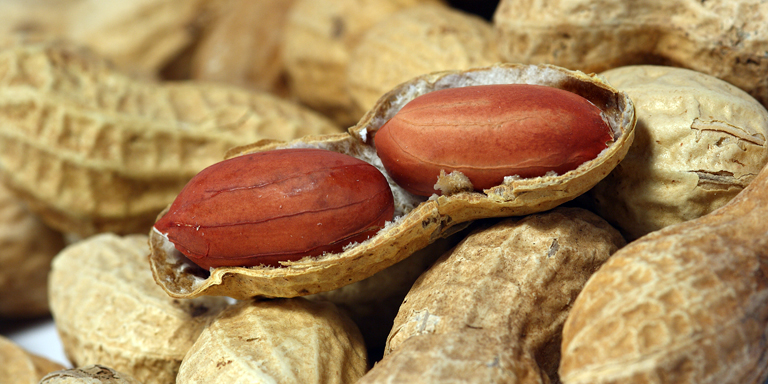Peanut allergy
With a peanut allergy, even the tiniest traces are enough to cause severe allergic reactions.

Table of contents:
Botanically, the peanut is not a nut but a legume. It is one of the foods where severe allergic reactions are especially common. The peanut is the primary trigger of anaphylaxis in children.
Triggers
Most peanut allergy sufferers have an allergic reaction to the storage proteins in peanuts. Heat and stomach acid do not affect the stability of these proteins. Peanuts can therefore cause allergic reactions in any form – whether eaten raw, roasted or cooked.
Most foods must be eaten in sufficient quantities to cause an allergic reaction. With peanuts, however, even eating milligram amounts is enough to cause life-threatening reactions. This is the reason why they are one of the most common causes of anaphylaxis.
Presence
Peanuts are present in peanut products such as peanut butter, peanut bars, peanut oil and roasted peanuts. They are also often present as a hidden allergen in Asian cuisine and in processed products such as ready meals and sweets. Purchasing guide in German «Einkaufshilfe Erdnussallergie».
Cross reactions
With a peanut allergy, cross reactions to other foods are possible – for example, to other legumes such as beans, soy, lentils, peas, garden peas, garden beans and products made from them such as tofu, soy yogurt and various other vegan and vegetarian products.
Course of the allergy
Peanut allergy typically first occurs in childhood. For most sufferers it is a lifelong allergy. If peanut allergy first occurs in adolescence or adulthood, it is usually a secondary allergy, or a cross allergy. The sufferers are really allergic to birch or grass pollen but also have a reaction to the food due to the similarity of the allergens. This allergy is often milder than the primary allergy and often affects just the mouth area.
Symptoms
As with all other food allergies, peanut allergy symptoms appear within minutes to an hour after consumption and typically include itching in the mucous membranes of the mouth and on the skin with redness, wheals and swelling. Like other food allergies, respiratory symptoms may also occur. Isolated gastrointestinal symptoms are rare. They usually occur in combination with other allergy symptoms, such as difficulty swallowing, nausea, vomiting, diarrhoea and bloating. In certain cases, the allergy may result in anaphylactic shock with breathing difficulties and circulatory collapse.
Diagnosis
Self-monitoring – ideally recorded in a symptom diary – and a consultation with an allergy specialist, together with the results of skin and blood tests, are the essential basis for the diagnosis of peanut allergy. To confirm the diagnosis and to determine the tolerance level, provocation (or challenge) tests may also be required.
Treatment
Strict avoidance of the food causing the allergy is essential. It is also essential to watch for concealed sources in bakery products, sausage, spice blends and semi-cooked and ready meals. If there is a risk of an anaphylactic reaction, it is essential to strictly avoid even the tiniest amounts (traces /contaminants). Whether traces can be tolerated should be decided by an allergy specialist. They may use a provocation or challenge test to determine the level of tolerance to the allergen.
A specialist dietician can provide helpful support in implementing treatment in daily life. For example, to learn how to read ingredient lists, to receive practical advice and to discuss possible changes to one’s personal daily life.
Anyone who has already suffered a severe allergic reaction should always carry an emergency medical ID card and an emergency kit to ensure prompt treatment of any further severe allergic reaction. In any event, once first aid has been administered, they should then seek medical attention from an emergency doctor or hospital.
Oral immunotherapy
Allergen-specific immunotherapy to peanut allergy has been investigated in a number of studies. This involves participants regularly taking gradually increasing tiny amounts of peanut under medical supervision so that the immune system gradually becomes accustomed to it. Some initial success has been achieved, but with a high number of undesirable effects, such as allergic reactions. The treatment is not yet generally available to sufferers in clinical practice. We strongly advise against attempting such treatment independently at home.
Labelling of food
The presence of peanuts in food must be declared in Switzerland and the EU. This means that the ingredient and any products produced from it are clearly labelled and highlighted on the packaging – for example, in bold type, italics or in capital letters. Unintentional mixtures/ combinations must also be mentioned at the end of the list as follows: “may contain …” or “may contain traces of …”. Sales staff in shops selling food (e.g. bakeries, butcher’s etc) and in restaurants, takeaway kiosks etc must also provide information. By law, information supplied verbally by a professional is adequate.
Tips and tricks
- Write the allergy-causing foods on a “visiting card” and hand to restaurant staff when ordering.
- Before holidays, have these cards translated into the local language and take them with you.
- When invited round to friends and family, either tell the hosts exactly about your allergy or offer to take something allergen-free with you.
- Check lists of ingredients of familiar foods before buying. The recipes can be changed at any time. If you are not sure, the manufacturers or wholesalers will be glad to provide information. Their contact details can be found on the packaging.
- When shopping, look out for products with the Allergy Seal of Quality, these are particularly suitable for people with allergies and intolerances and are recommended by aha! Swiss Allergy Centre.
Facts and figures
- Peanuts are one of the most common triggers of food allergy in children and the primary trigger in children over the age of three. As peanut allergy is often lifelong, it is also a common food allergy in adults.
- Peanuts are the primary trigger of anaphylactic reactions in children.
- Peanuts are the trigger in 1% of adults with a food allergy. They are, however, a common trigger of food-induced anaphylaxis.
Peanut allergy: FAQs
Must I give up eating all nuts if I have a peanut allergy?
No. Peanuts are not nuts but are classified botanically as legumes. A specialist should be consulted to determine if there are other food allergies present.
Must I give up eating all other legumes such as peas, beans, lentils, soy, and all other products made from them as well if I have a peanut allergy?
As the proteins in legumes are similar in structure, a cross reaction may occur. However, this is rare. A specialist should be consulted to determine whether there is any need to give up any other legumes.
Can I tolerate peanuts better if they are heated than when they are raw?
Peanuts contain both heat sensitive and heat stable allergens. People with a peanut allergy usually have a reaction to heat stable allergens, which is why peanuts usually cannot be tolerated even when they are processed or heated, as in cakes.
Is it safe for me to consume peanut oil?
With a very severe allergy, cold pressed peanut oils and other cold pressed oils – due to the risk of contamination – should be avoided. An allergy specialist should be consulted to determine how well peanut oil can be tolerated.
Must I also be careful with cosmetics that contain peanut oil?
Such cosmetics pose a risk for people with a peanut allergy and in extremely rare cases the amount of peanut protein present is sufficient to cause an allergic reaction. Children with atopic eczema, psoriasis or sensitive skin should also take care. People previously without allergy may also suddenly have an allergic reaction due to the impaired barrier function of the skin and continual skin contact with the allergen.
Peanut oil is a common ingredient in bath, skin and massage oils but is also present in other cosmetics. To avoid potential allergy triggers, it is important that those at risk thoroughly check the composition of cosmetic products before buying them.
But what specifically do you need to watch out for? Peanut oils come under the following names:
- Arachis hypogaea L. (peanut)
- Arachidis oleum
- Arachidis oleum hydrogenatum
- Arachidis oleum raffinatum PhEur
- Arachis hypogaea oil INCI
- Oleum arachidis
Eating out: What should I watch out for?
Peanut (butter) is a very common ingredient in the Asian, African, Mexican and American cuisines, for example, in peanut sauce, Satay skewers, Pad Thai and mole poblano. Peanut components and traces can also be found in desserts, brownies, biscuits, fried food, Guetzli (traditional Swiss biscuits) and snack items.
Must I give up peanuts for the rest of my life?
With a peanut allergy the likelihood of outgrowing the allergy is lower than with a milk or egg allergy. However, there are children who outgrow the allergy as they get older. An annual check with an allergy specialist is therefore recommended.
Is it possible to develop a tolerance to peanuts?
Certain sufferers can develop an oral tolerance to peanut proteins. It is best to consult an allergy specialist for further advice and information.
Editors: aha! Swiss Allergy Centre in co-operation with the Scientific Advisory Board.

